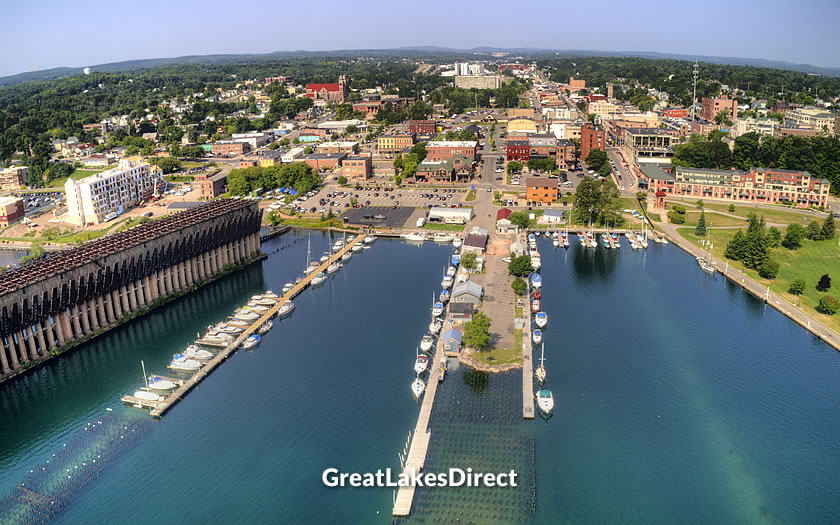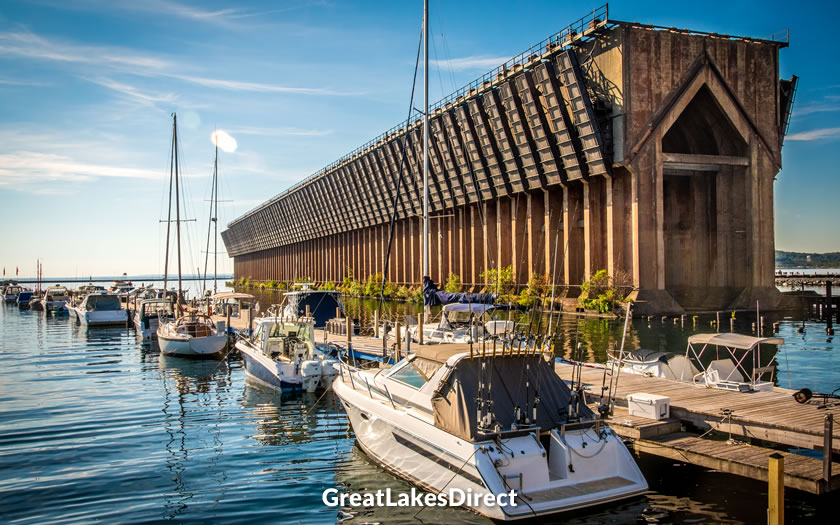Marquette is the largest city in Michigan's Upper Peninsula and is known for its stunning natural beauty and outdoor recreational opportunities.
The city is home to Northern Michigan University and boasts a lively downtown area with unique shops, restaurants, and breweries.

Aerial view of downtown Marquette
Marquette's Presque Isle Park offers breathtaking views of Lake Superior and features hiking trails, beaches, and a historic lighthouse.
The city also hosts numerous festivals throughout the year, including the popular Hiawatha Traditional Music Festival and the U.P. 200 Sled Dog Race.
Marquette is located on Marquette Bay in Michigan's Upper Peninsula. It is on the southern shoreline of Lake Superior, with the closest major metropolitan areas all in either Wisconsin or Minnesota.
Marquette is not only the largest city on the Upper Peninsula, but is the third-largest US city on Lake Superior (after Duluth and Superior). The city has more than 20,000 inhabitants, with a healthy and young proportion of those made up of the student population at Northern Michigan University.
Marquette Sawyer Regional Airport is the closest airport to Marquette. It is around 17 miles directly south of the city and offers daily connections to the large international airports at Chicago and Detroit.
The US-41 highway runs through Marquette on its way from Green Bay up to Copper Harbor. The highway is part of the Lake Superior Circle Tour.
The M-553 state highway passes the Marquette Mountain ski resort before heading south towards Marquette Sawyer Regional Airport and joining the M-35 at Gwynn.
The region where Marquette now stands was once inhabited by indigenous tribes, such as the Anishinaabe and Ojibwe people. The first Europeans to explore the area were French fur trappers and traders.
The city was founded in 1849 after deposits of iron ore were discovered nearby. It was originally named New Worcester but shortly afterwards the name was changed to Marquette to honor explorer Pere Marquette, who was a French Jesuit missionary and explorer who traveled through the region in the mid-17th century.

Marina and disused Lower Harbor ore dock in Marquette
The construction of the Lake Superior and Ishpeming Railroad further spurred the growth of the city and its iron mining industry and, by the late 19th century, Marquette had developed into a significant shipping and commercial center.
The construction of harbor facilities and lighthouses, such as the Marquette Harbor Lighthouse in 1853, helped solidify the city's maritime importance.
Northern Michigan University, founded in 1899 as a teachers' training school, contributed to Marquette's growth as an educational hub.
The Travel Marquette Visitor Center is located at 117 W. Washington St. in downtown Marquette and is open Monday-Friday.
Covering 323 acres of forest, beaches, and scenic views, Presque Isle Park is located just to the north of the city and is a popular destination for outdoor activities. The park features a number of hiking trails as well as several historic sites.
Top ten places to visit in Marquette from Northern Michigan University
A historical beacon constructed in 1853, the Marquette Harbor Lighthouse is an iconic landmark and a must-see for history enthusiasts. Visitors can walk the Marquette Harbor breakwall for stunning views of Lake Superior and the lighthouse.

Marquette Harbor Lighthouse
The Marquette Maritime Museum offers insights into the maritime history of the Great Lakes, including stories of sailors, shipbuilders, and lighthouse keepers. Visitors can explore exhibits featuring shipwrecks, maritime artifacts, and a restored lighthouse tower.
Sugarloaf Mountain is a popular spot for hiking and panoramic views. The hill is located a little further north than Presque Isle Park and towers 470 feet above Marquette. The hike to the summit is relatively short and rewarding, offering a spectacular 360-degree view of the surrounding landscape.

Downtown Marquette
Marquette is supposedly one of the 'snowiest' cities in the USA with 'lake effect' storms bringing constant dumps of the white stuff.
Marquette Mountain is a ski resort on the outskirts of the city. It offers 170 acres of downhill skiing with three chairlifts and a T-bar.
More information about the Upper Peninsula skiing is available here: Ski areas in the Upper Peninsula
Cross-country skiing is also popular in the area, with the Noquemanon Trail Network maintaining around 80 miles of groomed Nordic ski trails.

Munising is a small city located on the southern shore of Lake Superior, known as the gateway to the Pictured Rocks National Lakeshore. This unique geological formation features colorful cliffs, waterfalls, and pristine beaches that attract visitors from around the world. Munising is also close to Grand Island, a historic island offering hiking trails, beaches, and remnants of an old fishing village.

Copper Harbor is a small, picturesque town located at the northern tip of Michigan's Keweenaw Peninsula, known for its stunning natural beauty and rich mining history. Today, Copper Harbor is a popular destination for outdoor enthusiasts, offering world-class mountain biking trails, hiking, and scenic drives along the Brockway Mountain Drive.

Bayfield is a small city on the Wisconsin shore known as the "Gateway to the Apostle Islands", a group of 22 islands featuring pristine beaches, lighthouses, and sea caves. Bayfield is also famous for its annual Apple Festival, which features live music, arts and crafts as well as apple-themed treats.

Two Harbors is a port town located on Minnesota's North Shore of Lake Superior. The town is not far from the historic Split Rock Lighthouse, built in 1910 and offering stunning views of the lake. The Two Harbors area is also known for its unique geologic features, including the Gooseberry Falls State Park and the ancient lava flows at Palisade Head.
Marquette County Convention and Visitors Bureau : www.travelmarquette.com
Marquette Mountain Ski Resort : marquettemountain.com
Marquette Regional History Center : www.marquettehistory.org
Marquette Maritime Museum : mqtmaritimemuseum.com